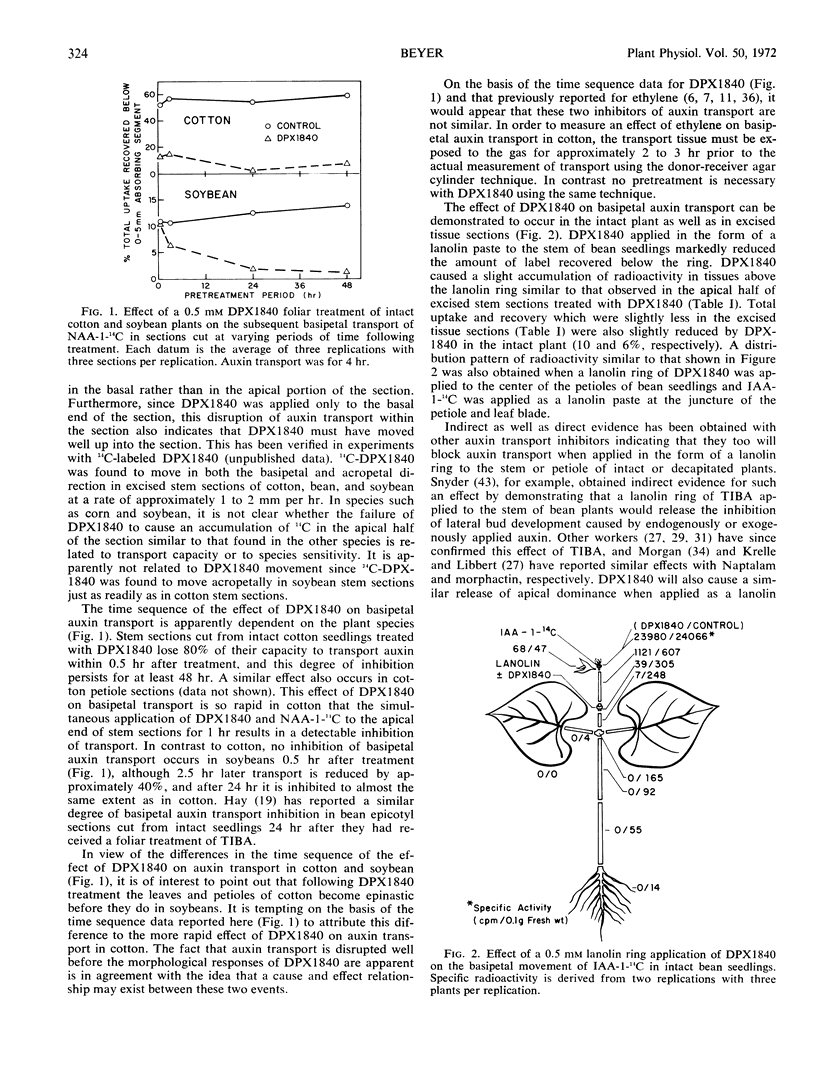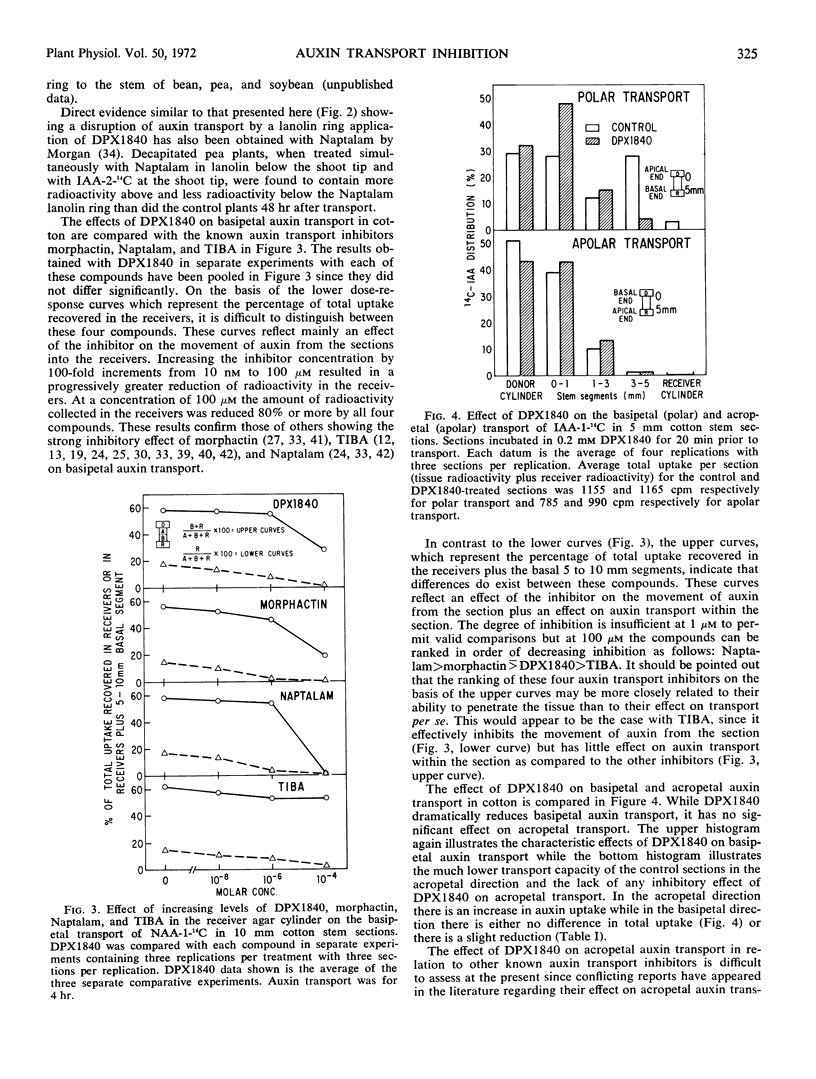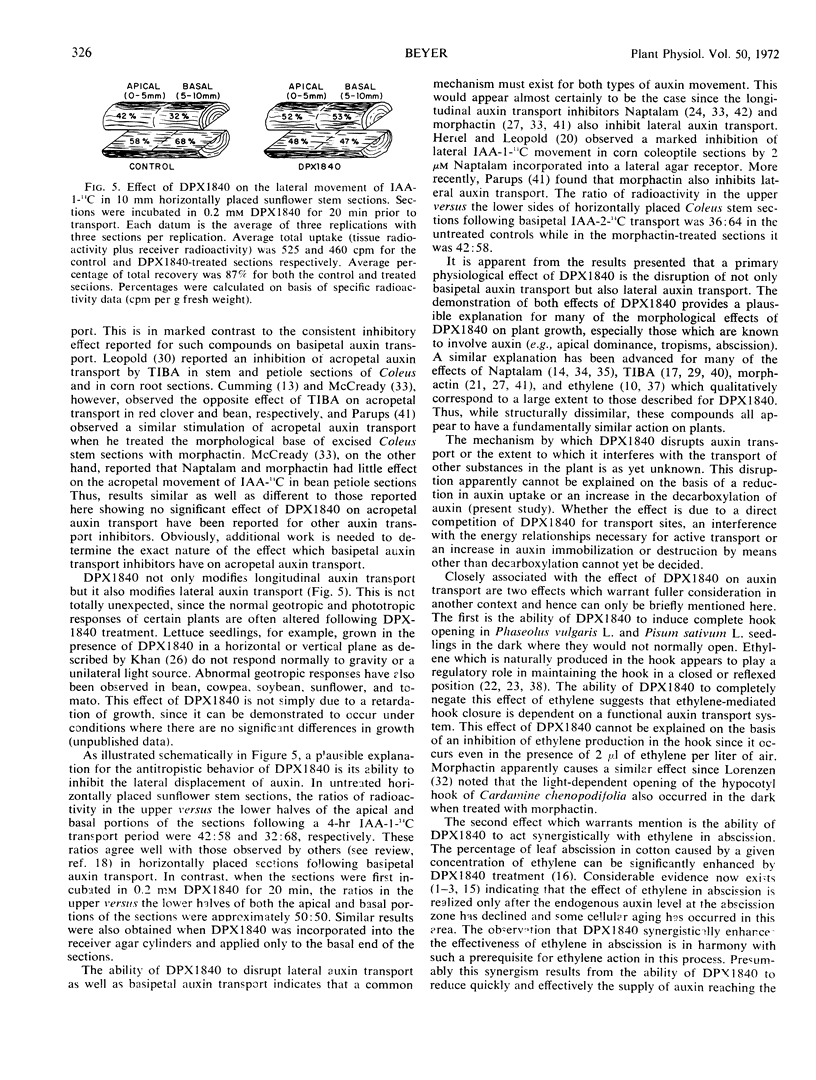Abstract
The new synthetic plant growth regulator DPX1840 (3,3a-dihydro-2-(p-methoxyphenyl)-8H-pyrazolo [5,1-a] isoindol-8-one) was examined for its effects on auxin transport. At a concentration of 0.5 mm in the receiver agar cylinders DPX1840 significantly inhibited the basipetal transport of naphthaleneacetic acid-1-14C in stem sections of Vigna sinensis Endl., Pisum sativum L., Phaseolus vulgaris L., Glycine max L., Helianthus annuus L., Gossypium hirsutum L., and Zea mays L. without significantly reducing total auxin uptake or recovery. The time sequence of the effect varied with the plant species. A similar inhibition of the basipetal movement of indoleacetic acid-1-14C was observed in intact seedlings of Phaseolus vulgaris L. In contrast to basipetal auxin transport DPX1840 had no significant effect on the acropetal movement of indoleacetic acid-1-14C in stem sections of Gossypium hirsutum L. Qualitatively the effect of DPX1840 on basipetal auxin transport was similar to that of other known auxin transport inhibitors. Quantitative differences, however, suggested the following order of activity: Naptalam>morphactin[unk]DPX1840>2,3,5-triiodobenzoic acid.
DPX1840 also inhibited the lateral displacement of auxin. In horizontally placed stem sections of Helianthus annuus L. pretreated with DPX1840, the ratio of radioactivity from indoleacetic acid-1-14C in the upper versus the lower halves of the sections following basipetal indoleacetic acid-1-14C transport was approximately 50:50, whereas in the corresponding controls it was approximately 40:60.
The data indicate that many of the characteristic effects of DPX1840 on plants, especially those which are known to involve auxin (e.g., epinasty, abscission, apical dominance, tropism), are due, at least in part, to its effects on auxin transport.
Full text
PDF





Selected References
These references are in PubMed. This may not be the complete list of references from this article.
- Abeles F. B., Holm R. E., Gahagan H. E. Abscission: the role of aging. Plant Physiol. 1967 Oct;42(10):1351–1356. doi: 10.1104/pp.42.10.1351. [DOI] [PMC free article] [PubMed] [Google Scholar]
- Abeles F. B. Role of RNA and protein synthesis in abscission. Plant Physiol. 1968 Sep;43(9 Pt B):1577–1586. [PMC free article] [PubMed] [Google Scholar]
- Beyer E. M., Morgan P. W. Abscission: the role of ethylene modification of auxin transport. Plant Physiol. 1971 Aug;48(2):208–212. doi: 10.1104/pp.48.2.208. [DOI] [PMC free article] [PubMed] [Google Scholar]
- Beyer E. M., Morgan P. W. Effect of ethylene on the uptake, distribution, and metabolism of indoleacetic Acid-1-C and -2-C and naphthaleneacetic Acid-1-C. Plant Physiol. 1970 Jul;46(1):157–162. doi: 10.1104/pp.46.1.157. [DOI] [PMC free article] [PubMed] [Google Scholar]
- Beyer E. M., Morgan P. W. Ethylene modification of an auxin pulse in cotton stem sections. Plant Physiol. 1969 Dec;44(12):1690–1694. doi: 10.1104/pp.44.12.1690. [DOI] [PMC free article] [PubMed] [Google Scholar]
- Burg S. P., Burg E. A. Inhibition of polar auxin transport by ethylene. Plant Physiol. 1967 Sep;42(9):1224–1228. doi: 10.1104/pp.42.9.1224. [DOI] [PMC free article] [PubMed] [Google Scholar]
- Burg S. P., Burg E. A. The interaction between auxin and ethylene and its role in plant growth. Proc Natl Acad Sci U S A. 1966 Feb;55(2):262–269. doi: 10.1073/pnas.55.2.262. [DOI] [PMC free article] [PubMed] [Google Scholar]
- Dela Fuente R. K., Leopold A. C. Senescence processes in leaf abscission. Plant Physiol. 1968 Sep;43(9 Pt B):1496–1502. [PMC free article] [PubMed] [Google Scholar]
- Hay J. R. The Effect of 2,4-Dichlorophenoxyacetic Acid and 2,3,5-Triiodobenzoic Acid on the Transport of Indoleacetic Acid. Plant Physiol. 1956 Mar;31(2):118–120. doi: 10.1104/pp.31.2.118. [DOI] [PMC free article] [PubMed] [Google Scholar]
- Kang B. G., Yocum C. S., Burg S. P., Ray P. M. Ethylene and carbon dioxide: mediation of hypocotyl hook-opening response. Science. 1967 May 19;156(3777):958–959. doi: 10.1126/science.156.3777.958. [DOI] [PubMed] [Google Scholar]
- Keitt G. W., Baker R. A. Auxin activity of substituted benzoic acids and their effect on polar auxin transport. Plant Physiol. 1966 Dec;41(10):1561–1569. doi: 10.1104/pp.41.10.1561. [DOI] [PMC free article] [PubMed] [Google Scholar]
- Keitt G. W., Skoog F. Effect of Some Substituted Benzoic Acids and Related Compounds on the Distribution of Callus Growth in Tobacco Stem Explants. Plant Physiol. 1959 Mar;34(2):117–122. doi: 10.1104/pp.34.2.117. [DOI] [PMC free article] [PubMed] [Google Scholar]
- Kumar M. A. Measurement of Ca 45 in serum by liquid scintillation. Int J Appl Radiat Isot. 1966 Sep;17(9):556–557. doi: 10.1016/0020-708x(66)90117-7. [DOI] [PubMed] [Google Scholar]
- LEOPOLD A. C. THE POLARITY OF AUXIN TRANSPORT. Brookhaven Symp Biol. 1964 Mar;16:218–234. [PubMed] [Google Scholar]
- Lorenzen H. Offnung des Hypokotylhakens von Cardamine chenopodifolia PERS. durch Morphaktin im Dunkel. Naturwissenschaften. 1968 Sep;55(9):451–451. doi: 10.1007/BF00602681. [DOI] [PubMed] [Google Scholar]
- MORGAN D. G. INFLUENCE OF ALPHA-NAPHTHYLPHTHALAMIC ACID ON THE MOVEMENT OF INDOLYL-3-ACETIC ACID IN PLANTS. Nature. 1964 Feb 1;201:476–477. doi: 10.1038/201476a0. [DOI] [PubMed] [Google Scholar]
- Morgan P. W., Gausman H. W. Effects of ethylene on auxin transport. Plant Physiol. 1966 Jan;41(1):45–52. doi: 10.1104/pp.41.1.45. [DOI] [PMC free article] [PubMed] [Google Scholar]
- Morgan P. W., Powell R. D. Involvement of ethylene in responses of etiolated bean hypocotyl hook to coumarin. Plant Physiol. 1970 May;45(5):553–557. doi: 10.1104/pp.45.5.553. [DOI] [PMC free article] [PubMed] [Google Scholar]
- Snyder W. E. SOME RESPONSES OF PLANTS TO 2,3,5-TRIIODOBENZOIC ACID. Plant Physiol. 1949 Apr;24(2):195–206. doi: 10.1104/pp.24.2.195. [DOI] [PMC free article] [PubMed] [Google Scholar]


